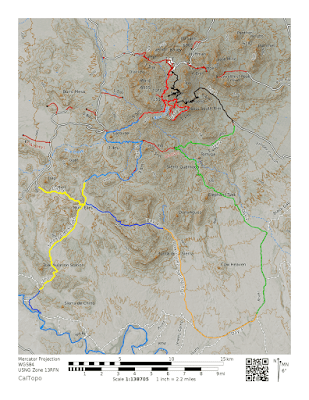A Guide to Keeping Your Dog Hydrated
Keeping Your Dog Hydrated
Just like people, our dogs need to stay cool and stay
hydrated. In BeeGee’s case, this is
extremely true because of her thick coat and dark color. She just absorbs all that Texas heat. One of the best ways to ensure your hiking
partner is getting enough water is to set up hourly water breaks or to provide
water every time you drink water. This
includes providing plenty of water before the hike, after the hike, and in
camp. To keep your dog healthy and
hydrated it is essential to carry along a water system for them as well.
 |
| BeeGee panting to keep cool on a hot day |
Dehydration
Dehydration is a negative fluid balance, which is caused by
water loss or decreased water intake.
Water can be lost in multiple ways such as panting, vomiting, diarrhea,
salivation, and infection. Whatever the
cause, dehydration leads to less blood to circulate and fewer intercellular
fluids. The big issue is that cells will
not receive adequate oxygen and nutrients, which results in decrease system and
organ function or even death.
While I don’t have explicit training in dog dehydration and
heat injuries, I have extensive training in humans and many of the signs,
symptoms, and treatments are the same.
Common signs and symptoms:
- Sunken eyes
- Lethargic
- Loss of appetite
- Dry mouth/nose
- Gums dry and sunken
- Confusion or odd behavior
- Loss of consciousness
- Failing the pinch test - lift the skin at your dog’s shoulders. If it does not fall or is slow to fall, that is a sign of dehydration.
 |
| The Pinch Test: this is where you lift the skin. Courtesy of Peteducation.com |
The key to realizing if your dog has become dehydrated is
paying attention to their behavior. If your
dog becomes tired and lethargic or is just acting different from normal, this
is a possible sign something is wrong.
Once we have determined something is possibly wrong, we can use the
symptoms above to determine if its dehydration.
I recommend using the pinch test and evaluating the gums because it has
provided the best results for BeeGee and me.
Treatment
Once we have determined our buddies are dehydrated or we
think they are, it is time to treat dehydration. The first step is to stop and find shade or a
cool location. A great place would be in
the shade by water so your dog can wet their stomach. If a body of water is available, take some of
your available water and wet their stomachs by hand. Through cooling off, we stop sweating or
panting and prevent even more water loss.
Depending on the severity of dehydration, this might be the end of your
adventure for a few hours or the rest of the day.
After you get your dog cool, the next step is ensuring water
is available. Put out your dog’s water
source so they can drink freely. Be
mindful though, that they may not want to drink any water until they have
cooled off, so it could take a while. As
a precaution or for more severe dehydration, you can add Pedialyte (salt
replenishing fluid for infants) to your dog’s water. Provide Pedialyte in a max of 50/50 mix with
water. The formula is approximately 1
ounce for every 10 pounds for dog weighs.
So a 50 lbs. dog should receive 5 oz. of Pedialyte in their water.
Finally, if everything you are doing is ineffective or you
feel like it’s not working; it is time to start planning your extraction. This could mean slowly walking out with a lot
of breaks to calling for rescue service.
If you feel it’s warranted or conditions persist and worsen by all means
call for help. I would rather look
foolish for a day than know I could have done more to help BeeGee.
Filtering
Just like you and me, dogs need to drink clean water as
well. It is true that dogs have a better
immune system and that their stomach is more acidic, but they are still
susceptible to water borne illnesses. In
addition, these illnesses can cause vomiting and diarrhea resulting in an
increased dehydration risk. Giardia and
Cryptosporidium, both protozoans, are the two largest threats to dogs drinking
out of lakes and rivers.
It is because of these waterborne illnesses that it is
important to treat or filter your dog’s water.
However, BeeGee prefers, what I considered yucky, water that is fresh
from the source and unfiltered. It can
be difficult to make sure she doesn’t drink any water. BeeGee likes to lie down in water to cool and
she always drinks while doing this. It
would be difficult to stop her from drinking while cooling off. The key is to use good judgment, try to avoid
murky, stagnant water around fields or livestock. Thankfully, dogs rarely get sick from
untreated water, but it is best not to push your luck. Filter your water when you can.
Final Thoughts
As with any post, these are just my thoughts so if you have
any questions or concerns make sure you consult your vet. Plus, keeping your dog hydrated is the key to
having a good trip with your buddy.
There have been a few occasions in the heat when I feel like I let
BeeGee get too hot. Now I try my best to
pay attention to her needs as well because it’s both our adventure not just
mine.
If you have any tips or tricks on keeping your dog cool and hydrated please share. Also, if you enjoy the blog, please follow us on Facebook.




Do you recommend any specific products to carry water for our dogs?
ReplyDeleteI use a bunch of different items depending on the conditions. Plus, I haven't fully worked out what works best, but I plan to do a post on our combinations soon.
Delete